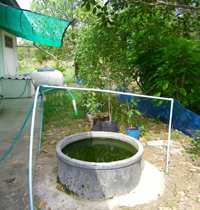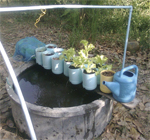|
 Imagine if you could produce your own fresh food in a small space and do it in an environmentally friendly and inexpensive way. Using aquaponics (a combination of aquaculture and hydroponics), you can! Imagine if you could produce your own fresh food in a small space and do it in an environmentally friendly and inexpensive way. Using aquaponics (a combination of aquaculture and hydroponics), you can!
The system is simple. Fish are kept in a tank with grow beds elevated around them. Water from the fish is used to irrigate and fertilize the plants. The root systems of the plants and the growing medium remove nitrates from the water to use as food. The water is returned by gravity to the fish tank, aerating the water as it falls into the tank. This is a closed system that conserves water, is organic, and closely mimics a natural ecosystem.
There are many ways to practice aquaponics, from small home aquarium tanks with a few salad greens growing in the inverted lid to warehouse-sized commercial operations. My family and I built a small system from all found and recycled materials. It is watered by hand (thirty minutes labor per day) so it does not use electricity. It takes up about one-and-a-half square meters of space.
The idea for this system came to me after some repairs had been done on the highway near where we live in rural Thailand. The road crews had left behind a broken piece of culvert and a small pile of pea gravel. So I thought, “Reduce, Reuse, Recycle!” I knew that the culvert could be used as a fish tank with a little cement work, so we carted it and the gravel home.
The first step was to create a base for the tank using chicken wire and cement left over from a previous project. The tank was placed on the base and sealed in place. Then the tank was then filled with water from our well. If you use chlorinated city water, remember to wait a week or so before putting fish in the system, in order to allow the chlorine time to dissipate.
Tilapia fry from one of our aquaculture tanks were placed in the tank and began the process of fertilizing the water. The only input into this aquaponic system is food for the fish. If you use an omnivorous fish like tilapia, all of their food can be grown for them. Duckweed is an excellent complete diet for tilapia.
Our “free” aquaponics system has been providing us with fresh greens and fish for six months now and will keep doing so for the foreseeable future.
For the planters, we collected used plastic containers from our village school and clinic. The tops were cut off and the containers washed very thoroughly three times. Then a hole was made in the side of each container’s base using an awl. This is to allow water to drain back to the tank. On the opposite side of the containers, near the top, a hole was punched to allow two containers to be connected using string. Doing this increases the number of containers that you will be able to fit on your shelf.
The plastic containers were filled with a mix of coconut fiber and rice husk because those are materials readily available for free where I live. If you use coconut product, you need to use chips and fiber, not the powdered coir soil amendment. If you are not sure of the source, it should be soaked and rinsed very well as it may have a high salt content. Coco chips are excellent in a hand powered aquaponic or hydroponic system, as they retain moisture very well while still having adequate air spaces for the plant roots.
An old board (see photo above right) from our farm’s plant nursery was given new life as the shelf for the containers. It is more common in aquaponics to use large growing beds but we were going with what we had or could source for Seeds were planted and gravel was placed on top to prevent the contents from floating out of the container when flooded during watering. Seedlings grown using hydroponic media could also be used instead of seeds.
The containers were placed on the board so that their drainage holes allow water to fall back into the tank. The containers were flooded with water from the tank using a watering can without its “showerhead”. (See photos, right)
Aquaponics meets all of the criteria for sustainable agriculture. It is environmentally sound, has minimum inputs, eliminates the solid waste disposal required by intensive aquaculture, and is socially responsible and economically viable.
Our “free” aquaponics system has been providing us with fresh greens and fish for six months now and will keep doing so for the foreseeable future.
Aquaponics meets all of the criteria for sustainable agriculture. It is environmentally sound, has minimum inputs, eliminates the solid waste disposal required by intensive aquaculture, and is socially responsible and economically viable.
Aquaponics provides you with an environmentally friendly way to raise fish and plants in a confined space. A hand powered system uses no electricity and minimal water. All fertilizer is provided organically by the fish. A system like this is also very helpful in teaching children how an integrated ecosystem (Planet Earth!) functions.
I find watching the fish and tending the plants very relaxing. I also love to eat the fresh produce and fillets that the system produces. Aquaponics is a sustainable, eco-friendly food production system that is in use from Antarctica to the Arctic circle and from the deserts of Arabia to the jungles of Thailand. If you have been thinking of producing more of your own food, aquaponics is one good way to go about it. This is truly the future of food production!
J. Steven (Steve) Bird is originally from Calgary but grew up both in Canada and Germany as his father was in the military. He has over thirty years international teaching experience. For the last twelve years he has been a farmer in Buriram province in northeast Thailand where he lives with his wife, son, and daughter. In addition to his farm duties, he also teaches English, Sustainable Agriculture, and swimming.
|

Materials Required
To build a small hand powered aquaponics system you need the following items:
- A tank to hold the fish. Anything that holds water can be used as a fish tank. Some ideas are large plastic tubs, pre-cast fiberglass tanks and solid-sided children’s wading pools. If you make your system portable (with the water removed), you could even use it indoors with the addition of grow lights. Good for those of you in cold, snowy locations!
- Container(s) for plants. Plants can be grown in a single large container, several medium-sized ones, or many small ones. Use your imagination and what is at hand.
- Some means to elevate the plants above the fish. We used an old board for a shelf.
- A watering device, such as a watering can without its head.
 
Tips on Start Up and Maintenance
- Place your fish in the tank at least a week before you add plants to the system to allow them time to fertilize the water. In a system this size, we have found no need to cycle water through the growing media before planting but many sources advise you to do this.
- Before watering your plants, swirl your hands gently through the water in order to put fish waste into suspension before filling the watering can. At some point you may find that you have an accumulation of waste. Move the fish to a temporary container, using the water from the tank, clean out the tank and return the fish and water.
- Flood your containers three times a day or more.
- Feed fish according to age and type.
- The water in the tank will need to be topped up because of evaporation. The best way to do this is with a strong spray. This fills up the tank and provides extra aeration for the fish.
Climate Considerations
Protective Structures
Here in Thailand, we need protection from torrential monsoon rains and also from forty-plus degree C temperatures. In temperate climates, you will need protection from frost and cold. In our system, there is a framework of three-quarter-inch PVC piping over it. This was made from bits of pipe and junctions left over from a greenhouse project. We use the frame to hold plastic sheeting in the monsoon season and shade net in the very hot season. In a temperate climate, such as most of the UK and the southern US, a single layer of thick plastic sheeting might suffice for plant protection. In colder climates, a small greenhouse structure would be better.
Plants and Fish
The types of plants that will grow in a garden are largely dependant on that garden’s location. Any plants that you are already growing successfully should do well in an aquaponics system. Water loving plants such as lettuce and other greens do very well in an aquaponic garden. Fish can be very temperature sensitive, so find out which types of fish do best in your climate. In almost all locations, a nearby fish hatchery should be able to provide both information and fish fry or fingerlings.
Brrrrrrrrrrrrrrrr Locations
If you live in a really cold location, consider making your system portable so that you can take it inside during the winter. Use of a plastic or fiberglass tank instead of concrete and the addition of grow lights make aquaponics possible all year round regardless of your location!
|

